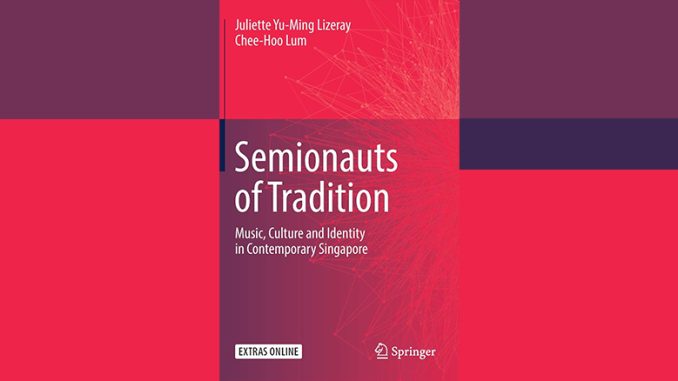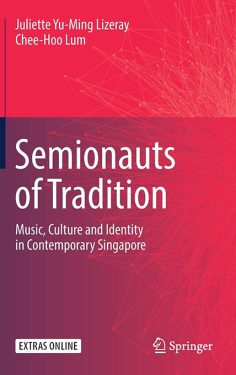
Title: Semionauts of Tradition: Music, Culture and Identity in Contemporary Singapore
Authors: Juliet Yu-Ming Lizeray, and Chee-Hoo Lum
Springer Singapore, 2022
Semionauts of Tradition is a book about how Singaporean musicians make sense and convey the meaning of their work based on their lived experiences as cultural workers. This labour of meaning-making and performativity is a constant work in progress, given that these cultural workers work within the confines of the Singaporean arts ecosystem. I have observed that the Singapore state often employs the arts as an extension of its developmental model project, which frequently changes in response to the wider context of nation-building and social development. To drive this instrumentalization of the arts, the state sets itself as the primary source of funding and resources through grants and performance opportunities. Given this backdrop, the cultural workers themselves navigate and negotiate their artistic works vis-à-vis the state narratives and cultural tropes that would allow them to ply work whilst still pursuing their artistic and aesthetic agendas and trajectories.
The authors Lizeray and Lum offer a framework that combines Ferdinand de Saussure’s theory of Semiotics, and Nicolas Bourriaud’s concepts of Semionautic Practice as well as Radicant, to help readers see how Singapore’s cultural workers strategically utilize and rework various cultural tropes borne out of their intersectional identities to re-imagine and present their musical and cultural signifiers. This framework allows us to see how cultural workers navigate the tension between the ideas of globalization and traditionalism imposed on them given that the Singapore state wants to be both relevant to the wider global markets and networks whilst retaining a “Singapore Core” predicated on the values of communalism and its own brand of multiculturalism. The authors suggest that the cultural workers navigate these tensions by repurposing and negotiating their positionalities and its associated accoutrements of cultural signs, meanings and forms, to vacillate between the traditional and the modern to address their artistic and material needs.
 There are ten chapters in the book, and each of them are connected through the questions laid out by the authors pertaining to how the aesthetic, ethnic, cultural and creative domains become constituent pieces of the imagined national identities. Each author employs their own respective discipline to tease out these answers from a series of interviews of artists whose work centres on employing ethno-cultural forms and genres, observations practices and performances, as well as references to other scholarly works. These data points, when placed together, forms pieces of the puzzle that shows the readers that individual and artistic agency can be seen in how the interlocuters approach these negotiations and meaning-making activities. Most of these chapters position the voice of the interlocutors as the focus whilst the authors provide insights and commentaries on how these articulations can be seen and understood through the theoretical lens of the Semionaut.
There are ten chapters in the book, and each of them are connected through the questions laid out by the authors pertaining to how the aesthetic, ethnic, cultural and creative domains become constituent pieces of the imagined national identities. Each author employs their own respective discipline to tease out these answers from a series of interviews of artists whose work centres on employing ethno-cultural forms and genres, observations practices and performances, as well as references to other scholarly works. These data points, when placed together, forms pieces of the puzzle that shows the readers that individual and artistic agency can be seen in how the interlocuters approach these negotiations and meaning-making activities. Most of these chapters position the voice of the interlocutors as the focus whilst the authors provide insights and commentaries on how these articulations can be seen and understood through the theoretical lens of the Semionaut.
I provide a brief overview of what I gleaned from the book proper. In Chapter Two, the reader journeys through the issues of national identity as an apparatus of the national/state agenda, and then moves towards looking at collaboration as a vehicle for intercultural exchange and as a means of performing distinct identities whilst maintaining individual roots and traditions in Chapter Three. We next read in Chapter Four the performing arts group NADI Singapura as a case to explore the fungibility of ethnicity – that the fluid construction and performativity of a ethno-cultural form can be an innovative enterprise that allows the cultural worker to access multiple spaces and markets.
Chapter Five details issues on the notion of fusion- the cross-cultural and inter-cultural acts of using cultural materials and mediums from ethnic groups other than those to which cultural workers belong. This act is mediated through the Singapore state’s imposition of its own brand of multiculturalism and the official narrative of being situated in a globalized space. Following that, we find a reprise of Chapter Four’s theme of constructing the performativity of ethnicity in Chapter Six, but this time in two frames in the context of Chineseness; the first being “classical” versus “contemporary”, and the second being the “hinterland” (construed by the interlocutors as Mainland China) versus “the (new) home”. After which, Chapter Seven explores the ideas of nostalgia encapsulated in the affects of tradition and ethnic heritage, and how cultural workers use and incorporate these tropes and elements in their own contemporary musical practice.
The final three chapters read like a collection of reflexive memos, conversations and interlocutor responses that collectively engage in a meta-enquiry of the book’s ambit. Chapter Eight details one of the author’s experiences in doing fieldwork and followed up with some suggestions on how ethnographic research sites and data points can be further expanded. The author also advocated that every researcher needs to expand the duty of care that researchers have for their interlocutors and gave the example of producing documentaries as part of said duty of care. Chapter Nine features materials and responses from the interlocutor themselves, where their thoughts on the preceding chapters where noted and curated, and Chapter Ten features the details of the cultural workers who are involved in the project as well as details of their organizations.
I found Semionauts of Tradition an insightful addition to the area of arts and cultural studies in Singapore, where the materials and arguments are presented in a systematic and concise manner that is easy to read, even for readers who are unfamiliar with the subject matter. There are two things that I would have wished that the authors could have engaged with or included in the book. Firstly, a chapter could been dedicated to how these interlocutors are engaged by state bodies as educators and instructors rather than performers, and that this adds a more nuanced slant on the relationship they have the with state. Secondly, while the ambit of the book looks at interlocutors who practice traditional art forms, perhaps this criteria could be somewhat expanded to include arts groups or individuals that forefront their ethnic identities whist embracing a different genre (Vedic Metal group RUDRA, for example). This would also provide a more nuanced view of what it means to construct and perform ethnicity. That said, I would highly recommend this book to everyone who has a keen interest in learning about ethnicity, culture and the ways of meaning-making and performativity.
Reviewed by Mohamed Shahril Bin Mohamed Salleh
Mohamed Shahril Bin Mohamed Salleh is the artistic director and founder of Vox Camerata.
